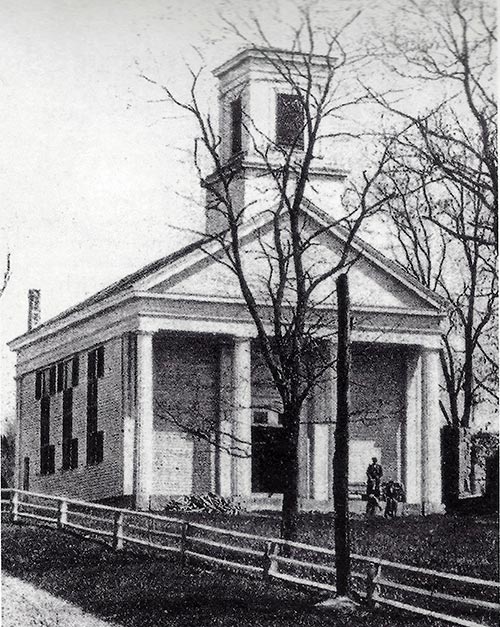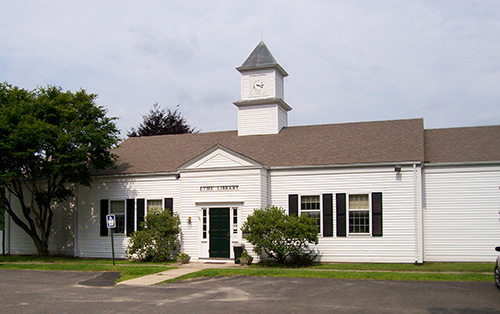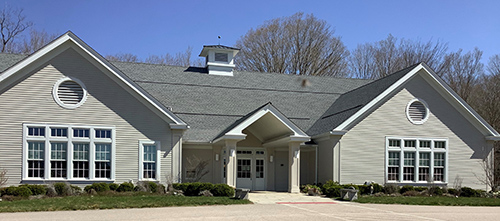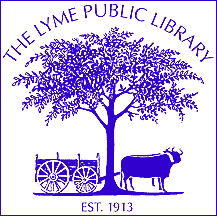
Library History
There was a library in Lyme long before the brand new one of today, and in a way it can be traced back to England. Beginning at the end of the seventeenth century, the clergy sent whole libraries to colonial settlements. Although the books were mostly theological and intended primarily for the clergy, they were also available to the general public. According to one source, there was a parish library in North Lyme in 1790, but how long it lasted is unknown. In time, however, as the numbers of readers increased and their tastes broadened, individuals sought a wider range of reading material. Inevitably, demand produced action.
In 1858 John Bill of Bill Hill offered part of his house for a public library. Neighbors raised $12.25 by subscription to purchase thirty-five books. Although there is no record of titles, the books apparently circulated until “the books were worn out.” A year later, in 1859, the Joshuatown Union Sewing Society established another library. Continuing for about six years, its purpose was to make books available to members and “to acquire and diffuse knowledge and to avoid sectarianism and bigotry.” If books were overdue, there were circulation rules and penalties. Book purchases were under-written by the sale of sewing projects and donations. Annual membership rosters reveal several familiar family names including LaPlace, Warner, Brockway, and Beebe.
It was not until 1912, however, that Charles M. Peck conceived the idea of a public library for the whole town. According to the remarks he made publically in 1913 he “conceived the idea that one of the greatest needs of our town was a free library.” He then consulted with the Secretary of the State Board of Education, who encouraged him to proceed. Starting with a house-to-house canvas, he wrote many letters of appeal for donations. Although some individuals turned him down, claiming “the town was already burdened with heavy debts,” others were encouraging and generous for those times. The first checks he received were for $35, $25, $10, and $70. Subsequently, a sufficient number of subscriptions assured the next step. Contributions also came from beyond Lyme’s borders including one from the Lyme Art Exhibition, now the Lyme Art Association. It devoted one day of sales to “Hamburg Day,” with the proceeds going to the new library.
Consequently, a year after Peck’s first efforts, on September 27, 1913, William Marvin, Lyme Town Clerk, put out the call: “The legal voters of the Town of Lyme are warned to meet on Monday, October 6th, at 9AM to take action on the matter of establishing a free public library and appointing a Board of Directors for same.”
According to the minutes of the town meeting on October 6, 1913, J. Warren Stark served as chair of the meeting. The meeting opened with the reading of the motion “to establish a Free Public Library and to appropriate therefore such amount as may be turned into the treasury for that purpose by subscription.” Further provisions were voted to establish a board of directors and for the town to provide not less than one dollar for the maintenance and development of the new library. For the same purpose the sum of $250 from private sub-scribers was also approved. In addition, the new directors were authorized to “provide a suitable room and establish same within one mile of Hamburg Center and also to provide branch libraries at Hadlyme and Grassy Hill.” Some of the names of the first board of directors are still familiar today, including Ely, Bill, Reynolds, Geer and Harding.

The Board of Directors’ first annual meeting held on October 10, 1913 was a busy one. It accepted a copy of Jack London’s newest book, John Barleycorn, and added $50 dollars to the budget for shelving additional books. In addition, it accepted a donation of $47 for the same purpose, from the Ladies Benevolent Society of the Lyme Congregational Church, provided that the shelving be bought and installed by a resident of the town.
In 1913 the town government’s work was held on the ground floor of the Lyme Congregational Church, which it had leased for ninety-nine years. The town, in turn, gave the platform or stage area rent-free to the library. Fortuitously, the state which had jurisdiction over libraries waived its right to order books but maintained its right to censor those it declared unacceptable. For almost forty years, the town library and church shared the same building. In 1952, however, the town broke its lease with the church because it needed an auditorium. Consequently, the library was moved from the stage area with the books for adults moved to the south wall of the room and the books for children moved to the Lyme School.

In 1967, recognizing the need for more space and a library building, the Board of Directors established a building committee. Residents of the town were asked to raise $70,000 through tag sales, a barn auction at the Harding Farm, as well as through private contributions and a grant from the state. Mr. and Mrs. Richard D. Ely and James Thach were selected as cochairmen, and Jerry Ballek treasurer. Two years later, on May 10, 1969, a resolution passed at a town meeting provided for a new library site and building. The ground breaking took place in 1969, and the dedication on March 6, 1971. Designed by Crabtree Associates in Hartford, the building cost $80,000. In 1981, an additional 1,200 square feet were added to the rear for a children’s library.
In the fall of 2008, the town’s selectmen realized that the demands on both the town hall and the library required still more space. The vault at the town hall was too small and meeting space inadequate. The library no longer met code requirements and the spaces were inappropriate for current uses. The selectmen therefore appointed a Town Campus Center Planning Committee and charged it to produce a plan for the two buildings that would meet current needs and those for the next thirty years. The committee began its deliberations in 2009 and began consultations with town residents, administrators, engineers, and architects. After several town meetings, a referendum was held on May, 22, 2012, and passed with 266 residents in favor and 108 opposed. Ground breaking for the project took place on October 17, 2013, the library’s centennial year. The new center, incorporating an enlarged Town Hall and new Library as well as a “town green” and parking spaces in between, provide a true town center for the first time in its history. The new Library, which opened its doors on October 7, 2014, includes expanded high-speed Internet as well as updated technology systems for staff and patrons. A portion of the building houses the Lyme Local History Archives, which were formerly kept at the Public Hall.

Today our library is very different from what it was one hundred years ago. It has its own building and much more than books. Its mission is to serve “the town of Lyme as a community center for lifelong education, cultural and recreational activities, and evolving information needs.” There are 22,940 books on the shelves, over 2,200 DVDs, and over 800 books on cd. In addition, there are tens of thousands of digital titles available through streaming services such as Overdrive, Hoopla, and Kanopy. Thanks to a grant from the MacCurdy Salisbury Foundation in 1982 and other sources, our library was the first library in the state to purchase computer terminals. It now has seven desktop terminals for patrons’ use, as well as laptops, tablets, and a Wi-Fi hotspot.
Over the years, the Library has been the beneficiary of many monetary gifts for the annual budget, the endowment, and programs. It has also received patrons’ collections about horticulture, film, and cooking as well as the personal library of Dominick Dunne. A bequest from Mildred Bruestle, and her husband, both long-time residents of Lyme, amounted to $240,000. In September 2008 the Library received $100,000 from the Community Foundation of Southeastern Connecticut, which it donated to the Town Campus Center project.
